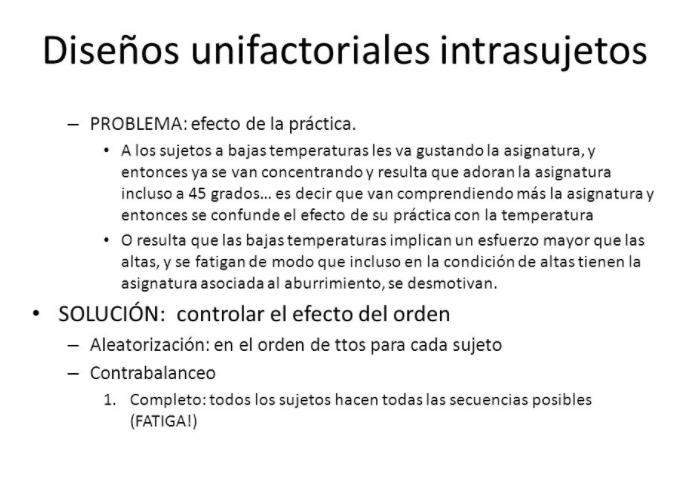Unifactorial designs

- 3007
- 241
- Perry Hirthe
The fundamental characteristic of this design is that the same subjects pass all the experimental conditions. Comparisons between conditions are made and for them the measures of each subject are used in each condition. We define an intra-subject design as a way of studying the behavior of the same group of people under different conditions.
You may also be interested: Latin square and square design GrecolatinoAn intra-subject unifactorial design
An intra-subject unifactorial design is one in which:
- There is an independent variable
- Several observation units are created according to their levels
- The dependent variable can be one or more
- Several effects can be studied in the dependent variable produced when the independent variable varies.
- Experimental groups are formed by the same subjects
- The experimenter has manipulated the independent and controlled variable the influence of possible intervening variables.
Psychophysical studies
Psychophysics aims to determine relationships between the physical field (with objective measures) and the psychological field (with subjective means).
Use two sources of measure: the one given by the instruments and the one given by the subjects. We intend to know how the subject perceives the world around him. Suppose that an perfume company wants to study how subjects perceive 7 different concentrations of one of their perfumes through smell. We have only one independent variable: perfume concentration. This variable has 7 levels that would be perfume concentrations in percentage units. If we chose an inter-subject design to carry out our experiment, we would need 7 groups of different subjects, one to judge each concentration. However, this study can be conducted with only 10 subjects using an intra-subject design.
The 10 subjects evaluate the 7 perfume bottles. For the evaluation of the smell, each subject is asked to judge the intensity of the smell in each bottle, assigning numbers between 0 and 50. The 55% concentration bottle is used as a reference smell and the numerical value 8 is assigned to this bottle. This is the magnitudes estimation technique using the standard (the medium bottle) with a module (number 8). The numerical judgment on the intensity of the smell for each subject was the dependent variable.
You wanted to analyze the responses of each subject. To do this, an equation is obtained that relates the stimulus to the subject's response. All equations approached the real estimates given by the subjects, but there were great individual differences in the way of perceiving perfume.
Learning studies
In some investigations, The intra-subject design is the only one that can be applied. For example, this occurs with learning studies. Seligman discovered the phenomenon of learned helplessness using an intra-subject design.
Animals were exposed to a discharge that they could not avoid for a while. After this time, when they were offered the possibility of escaping from discharges by jumping a barrier, the animals did not do it and suffered the downloads.
The animals had learned to be helpless Before downloading (and in the face of cruelty and human stupidity). This fact reveals an individual learning over time and only this phenomenon could be discovered considering as an experimental unit the same animals all the time.
This article is merely informative, in psychology-online we have no power to make a diagnosis or recommend a treatment. We invite you to go to a psychologist to treat your particular case.
If you want to read more articles similar to Unifactorial designs, We recommend that you enter our category of experimental psychology.

